Documentary of the 2024 International Joint Course - Field Biology

Written by: Li Yan, Chen Yi-Hui
From August 12 to August 18, 2024, the Department of Life Sciences at our university's College of Science and the Department of Biological Sciences at the University of the Ryukyus conducted a joint English-language summer course. This year's course was taught and organized by Professor Liao Qi-Zheng, Associate Professor Chen Yi-Hui, and Assistant Professor Zeng Yi-Jie from our Department of Life Sciences. Students from the Department of Biology at the University of the Ryukyus were led by Professors Izawa Masako, Taden Tetsuro, and Assistant Professor Kobayashi Shun to attend classes in Taiwan. The field courses and presentations took place at Alibang Eco-Farm in New Taipei City. The course was designed to mix Taiwanese and Japanese students into groups and teach background knowledge on specific experimental topics. This year's theme was "The Effects of Habitat Ecological Factors on Plant Growth and Physiological Responses," exploring the relationship between environmental light, temperature, humidity, soil characteristics, and chlorophyll content and leaf morphology. The course involved field observations and data collection in groups, followed by data analysis, scientific drawing, and oral presentations, all conducted in English.
Course Flow
August 12 marked the first day of the course. Professor Liao Qi-Zheng, Associate Professor Chen Yi-Hui, Assistant Professor Zeng Yi-Jie, and course assistants and students each went to Taoyuan International Airport to greet their counterparts. After meeting the faculty and students from the Department of Biology at the University of the Ryukyus, group assignments were made, and members introduced themselves briefly. All participants took a tour bus to Tamsui Old Street, where they purchased dinner and snacks before heading to the Alibang Eco-Farm, the location for classes and fieldwork. Upon arrival, Alibang staff gave a brief introduction to the environment and safety precautions. That evening, all faculty and students gathered in the conference room for introductions and an overview of the upcoming course schedule. This course was designed to emphasize group-based learning, so the day's main activity focused on group members getting to know each other.
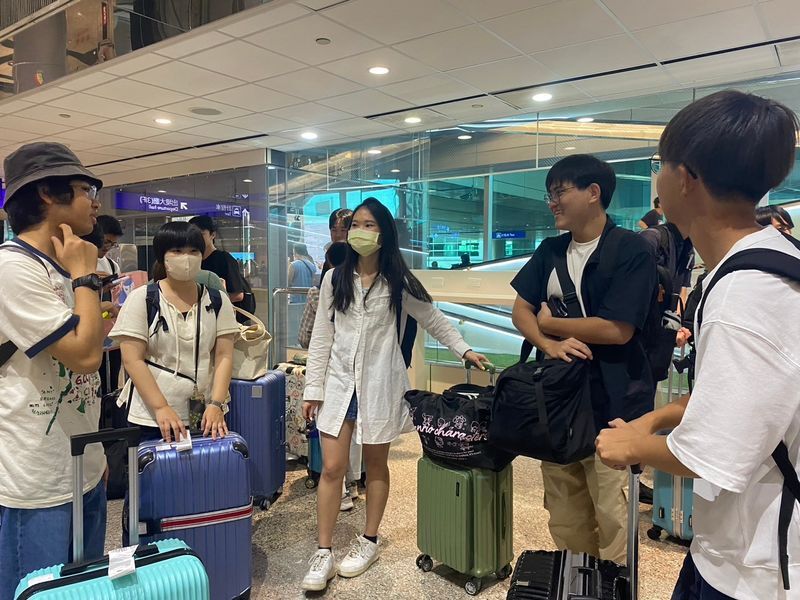 Group members introducing themselves (Photo by: Murakami Yuumi)
Group members introducing themselves (Photo by: Murakami Yuumi)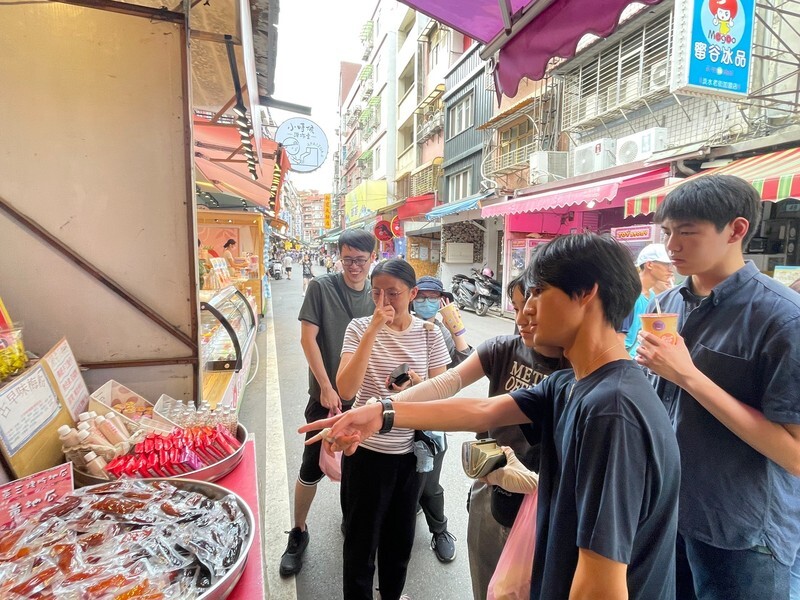 Teachers and students visiting Tamsui Old Street (Photo by: Chen Yi-Hui)
Teachers and students visiting Tamsui Old Street (Photo by: Chen Yi-Hui)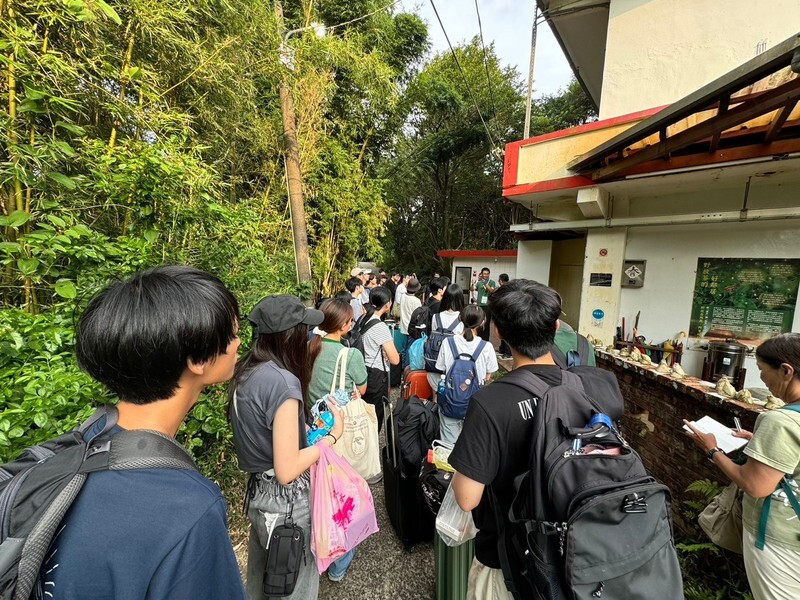 Alibang staff introducing the environment (Photo by: Zhang Qiao-Zhu)
Alibang staff introducing the environment (Photo by: Zhang Qiao-Zhu)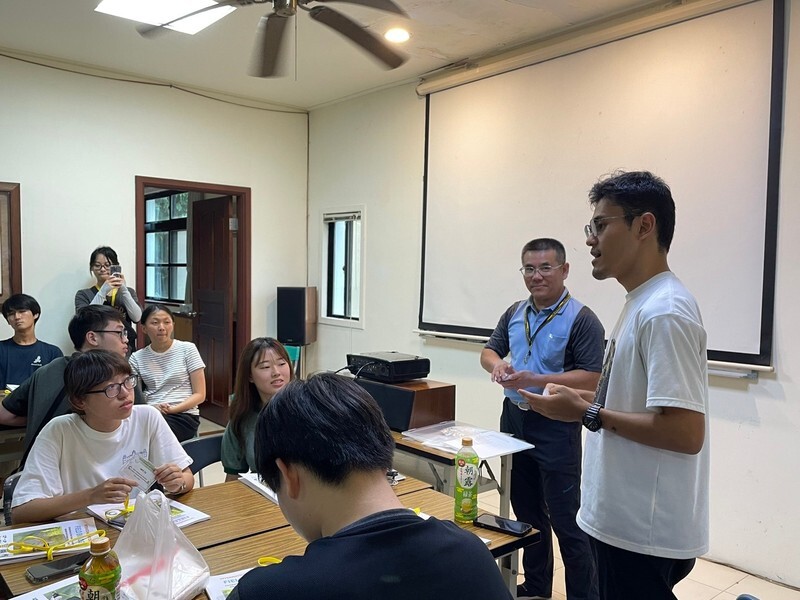 All teachers and students introducing themselves in the conference room (Photo by: Li Yan)
All teachers and students introducing themselves in the conference room (Photo by: Li Yan)Day 2 (August 13) officially began with Professor Liao Qi-Zheng explaining the differences in leaf morphology and environmental factors under varying light intensities, followed by an introduction to the main experimental process. Assistant Professor Zeng Yi-Jie then introduced the instruments used in the experiment, starting with the principles and operation of the CCM-200 plus for measuring relative chlorophyll content. The students then moved outdoors, guided by Professors Liao Qi-Zheng and Taden Tetsuro, to identify target plant species. Each group began marking plants, measuring relative chlorophyll content using the CCM-200 plus, and collecting leaf samples. After lunch, Professor Liao held a quiz session on the experimental plants, followed by Assistant Professor Zeng teaching students how to use ImageJ software to measure leaf length, width, area, and thickness, with all groups participating in hands-on practice.
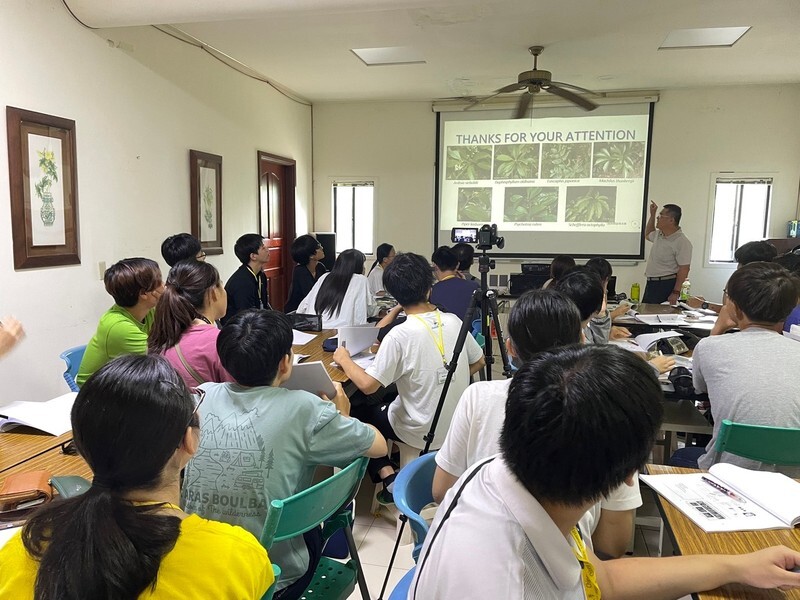 Professor Liao Qi-Zheng teaching (Photo by: Li Yan)
Professor Liao Qi-Zheng teaching (Photo by: Li Yan)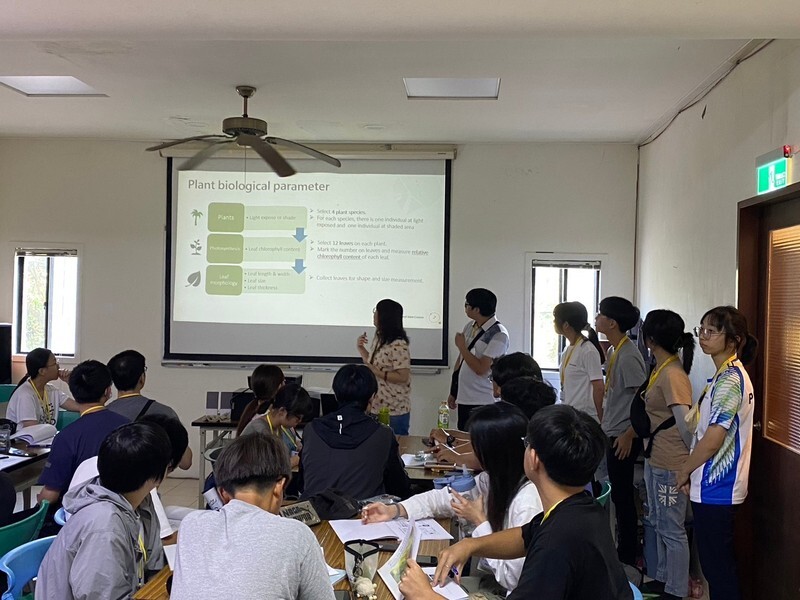 Assistant Professor Zeng Yi-Jie teaching (Photo by: Taden Tetsuro)
Assistant Professor Zeng Yi-Jie teaching (Photo by: Taden Tetsuro)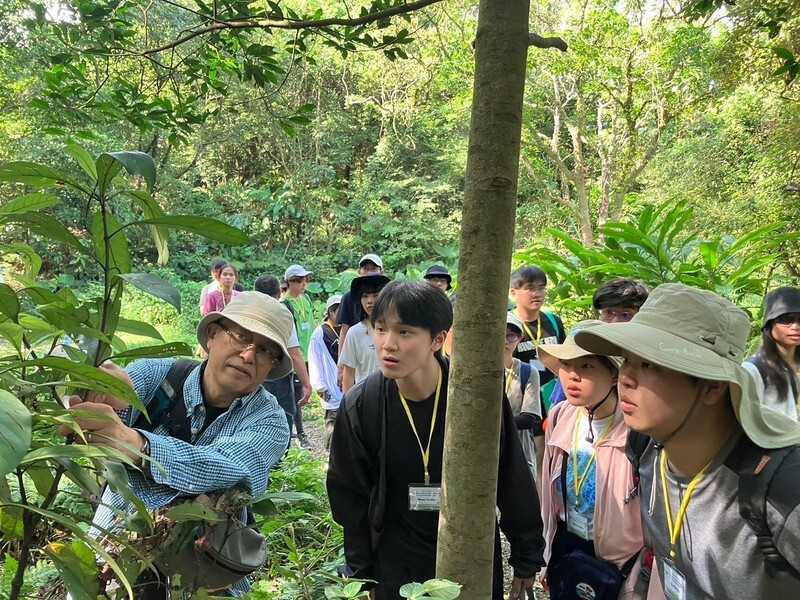 Professor Taden Tetsuro instructing students on identification (Photo by: Higashi Teppei)
Professor Taden Tetsuro instructing students on identification (Photo by: Higashi Teppei)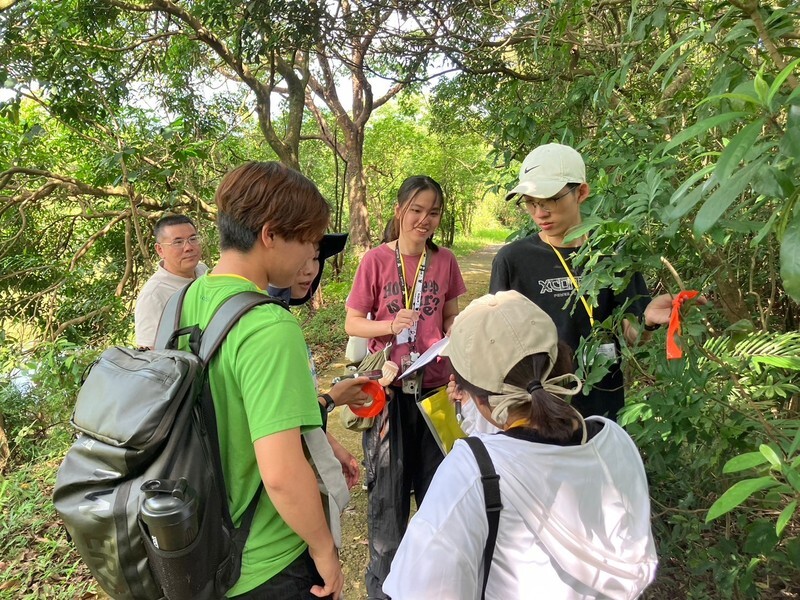 Groups marking plants and measuring chlorophyll content (Photo by: Higashi Teppei)
Groups marking plants and measuring chlorophyll content (Photo by: Higashi Teppei)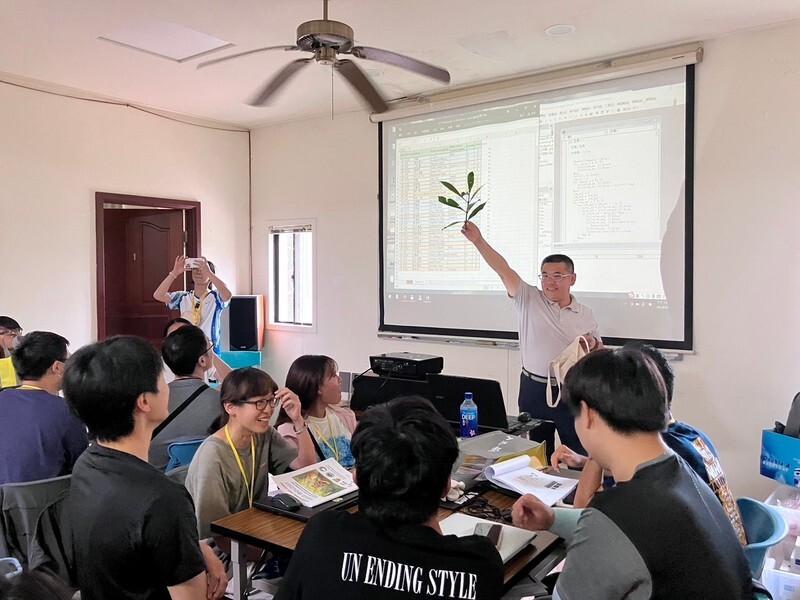 Professor Liao Qi-Zheng conducting a quiz on plants (Photo by: Higashi Teppei)
Professor Liao Qi-Zheng conducting a quiz on plants (Photo by: Higashi Teppei)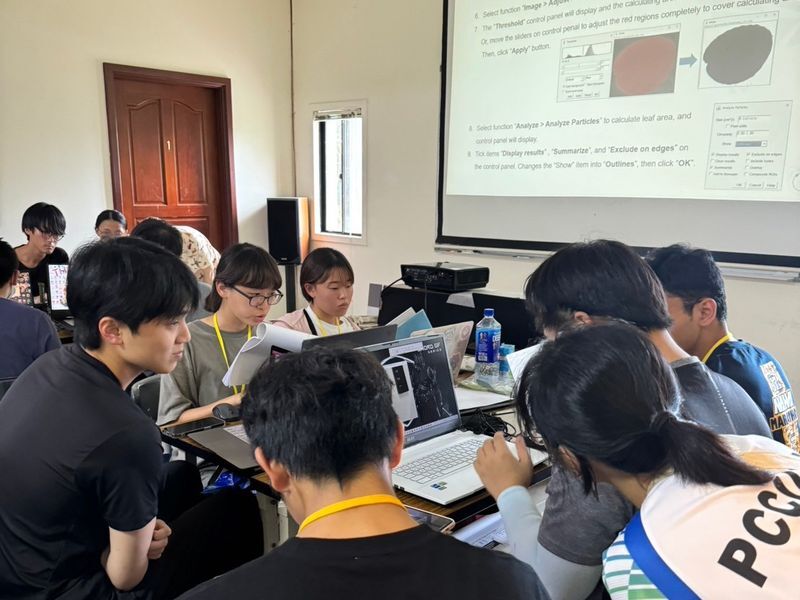 Assistant Professor Zeng Yi-Jie teaching leaf area calculation (Photo by: Zhang Qiao-Zhu)
Assistant Professor Zeng Yi-Jie teaching leaf area calculation (Photo by: Zhang Qiao-Zhu)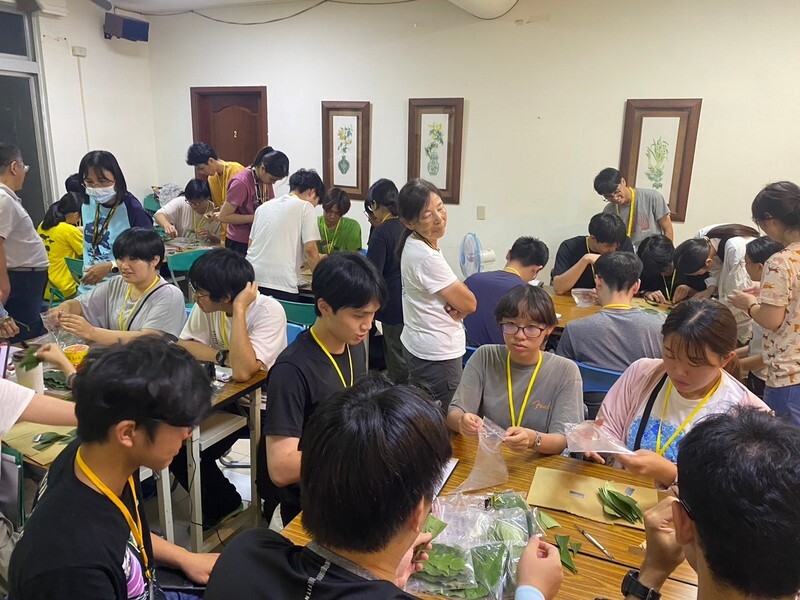 Teachers and assistants checking each group's progress (Photo by: Murakami Yuumi)
Teachers and assistants checking each group's progress (Photo by: Murakami Yuumi)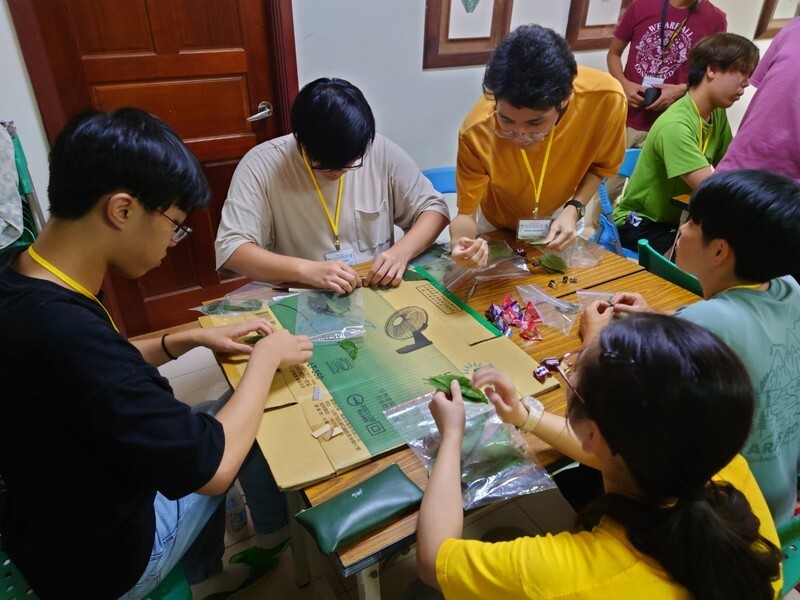 Groups measuring leaf thickness (Photo by: Xu Zhi-Fan)
Groups measuring leaf thickness (Photo by: Xu Zhi-Fan)Day 3(August 14) After breakfast, Assistant Professor I-Chieh Tseng taught students how to operate the microclimate measurement instruments. Following this, the teachers and student groups moved outdoors to measure microclimate data using the instruments, while the teaching assistants used CCM300 and CCM-200 plus to measure absolute and relative chlorophyll content, collecting data for later experimental calculations. After each group completed the microclimate data measurements, at 10 a.m., the teachers and students participated together in the Alibang Stream Ecology Exploration activity. The staff of Alibang divided the students into two groups and led them to the stream, where they introduced and helped the students search for aquatic organisms living in the stream. Just as the stream exploration was ending and everyone was about to leave, it started raining, and the rain gradually became heavier. Although some of the teachers and students had rain gear, most were completely soaked by the downpour (The weather is indeed hard to predict!). Due to the weather, the course schedule was slightly adjusted. In the afternoon, Assistant Professor I-Chieh Tseng taught the students the operating principles of the Pulse meter, how to connect it to mobile phones, and how to use it. The following session was taught by Professor Chi-Cheng Liao, who instructed students on how to use RStudio to calculate absolute chlorophyll content. Since some students may have encountered issues such as typing errors, failure to retrieve data, or other problems when entering code, most students spent a significant amount of time repeatedly running the code and debugging. The teachers and teaching assistants worked together to assist the students until the evening.
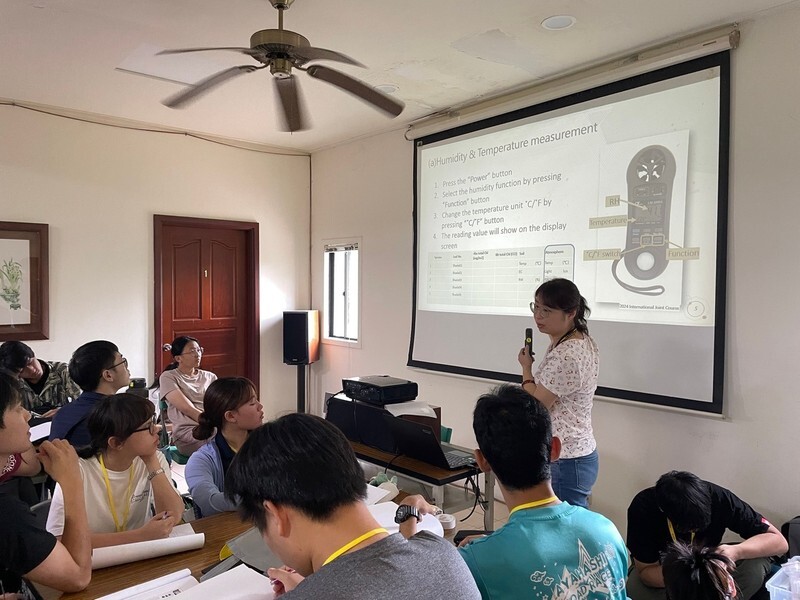 Assistant Professor I-Chieh Tseng teaching how to use the microclimate measurement instruments
Assistant Professor I-Chieh Tseng teaching how to use the microclimate measurement instruments.jpg) Students from each group measuring microclimate data (Photographer: I-Chieh Tseng)
Students from each group measuring microclimate data (Photographer: I-Chieh Tseng).jpg) Teaching assistants using CCM300 to measure absolute chlorophyll content (Photographer: I-Chieh Tseng)
Teaching assistants using CCM300 to measure absolute chlorophyll content (Photographer: I-Chieh Tseng).jpg) Alibang staff introducing aquatic organisms (Photographer: Yen Li)
Alibang staff introducing aquatic organisms (Photographer: Yen Li)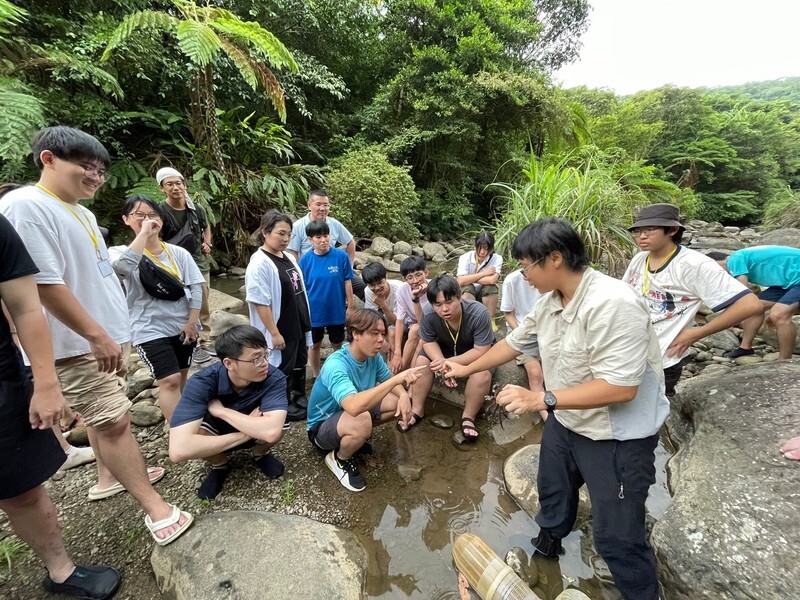 Alibang staff introducing aquatic organisms (Photographer: Yen Li)
Alibang staff introducing aquatic organisms (Photographer: Yen Li) Assistant Professor I-Chieh Tseng teaching students how to use the Pulse meter (Photographer: Tetsuhei Higashi)
Assistant Professor I-Chieh Tseng teaching students how to use the Pulse meter (Photographer: Tetsuhei Higashi)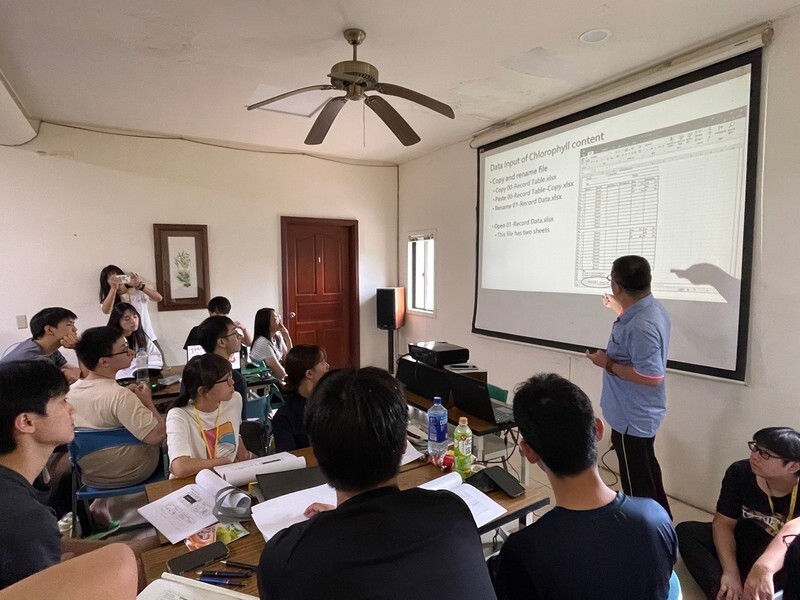 Professor Chi-Cheng Liao teaching how to use RStudio to calculate absolute chlorophyll content (Photographer: Yen Li)
Professor Chi-Cheng Liao teaching how to use RStudio to calculate absolute chlorophyll content (Photographer: Yen Li)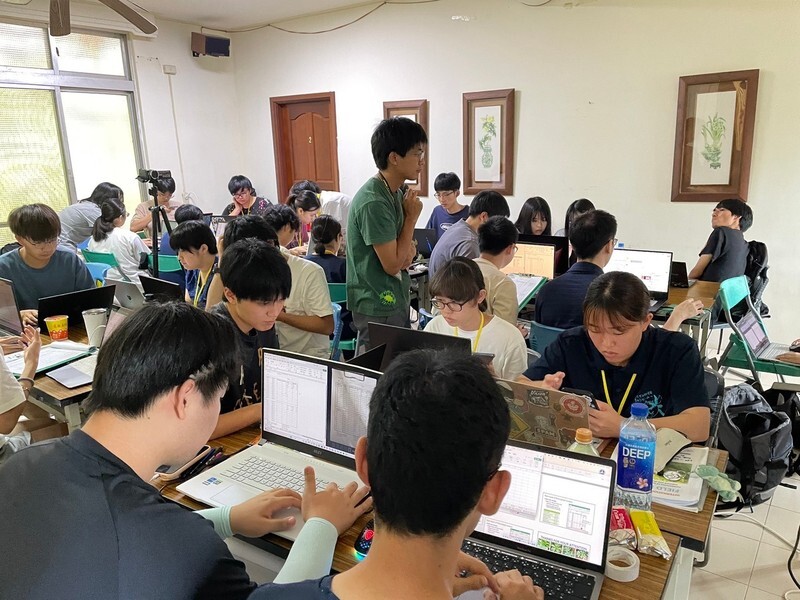 Students from each group using RStudio to calculate absolute chlorophyll content (Photographer: Yen Li)
Students from each group using RStudio to calculate absolute chlorophyll content (Photographer: Yen Li)Day 4(August 15) The first class of the day was led by Assistant Professor I-Chieh Tseng, who guided the students in using a pH meter to measure the pH of soil. Afterward, the students moved outdoors to collect soil samples near the experimental plants. Once each group had collected their samples and returned to the small farm hut, Assistant Professor I-Chieh Tseng explained the experimental procedure for using the pH meter. Each group also used a Pulse meter to measure the soil’s temperature, nutrient ion content, and water content. During the experiment, the sky gradually darkened and a heavy rain began. Some students volunteered to rush back to the dormitory to fetch umbrellas for everyone, ensuring that their classmates and teachers stayed dry. The Alibang staff mentioned that such heavy rain is rare in this area during summer, and we were "lucky" to experience it! After returning to the meeting room, Professor Chi-Cheng Liao briefly explained the subsequent analysis process and the basic format of the report. The remaining time was given to the student groups to prepare for tomorrow's presentations. During this time, the teachers and teaching assistants continuously helped the groups with questions. The students worked tirelessly late into the night, preparing for the oral presentations to be given the next day.
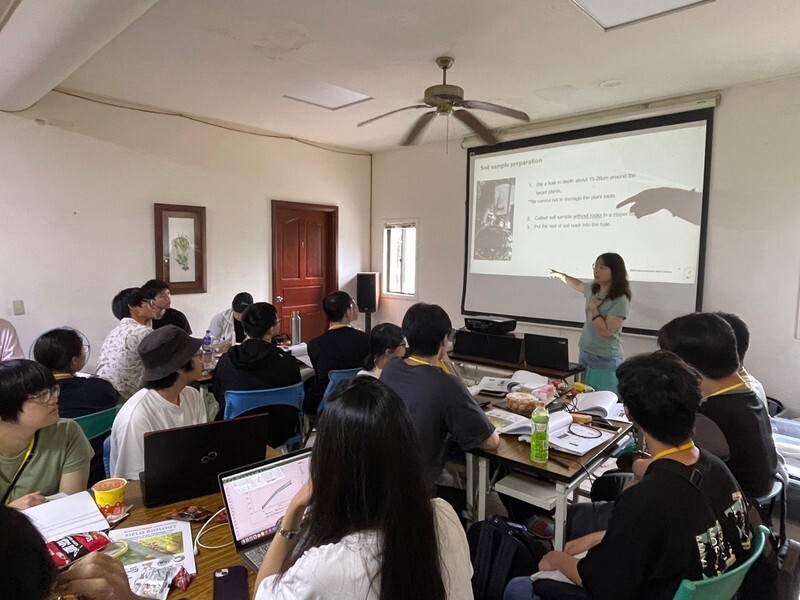 Assistant Professor I-Chieh Tseng teaching the class (Photographer: Yen Li)
Assistant Professor I-Chieh Tseng teaching the class (Photographer: Yen Li).jpg) Students using the Pulse meter to measure data (Photographer: I-Chieh Tseng)
Students using the Pulse meter to measure data (Photographer: I-Chieh Tseng)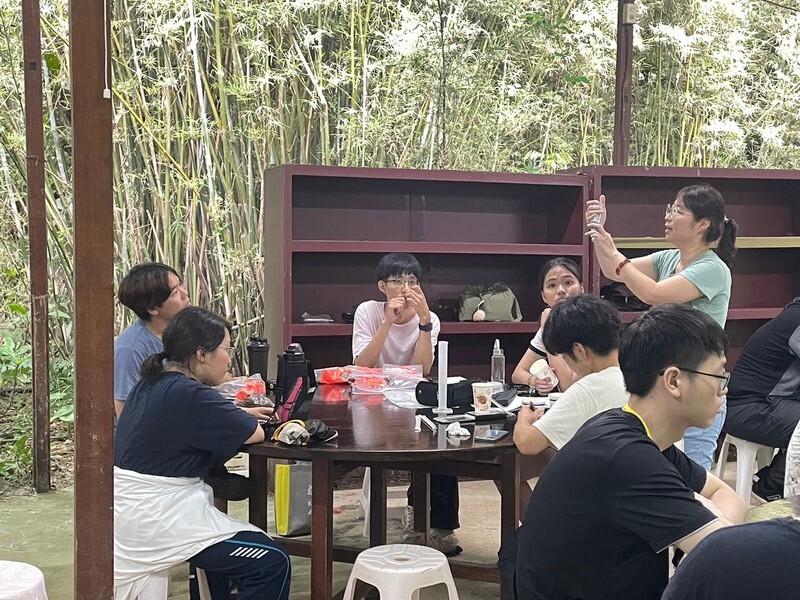 Assistant Professor I-Chieh Tseng teaching how to use the pH meter (Photographer: Yen Li)
Assistant Professor I-Chieh Tseng teaching how to use the pH meter (Photographer: Yen Li)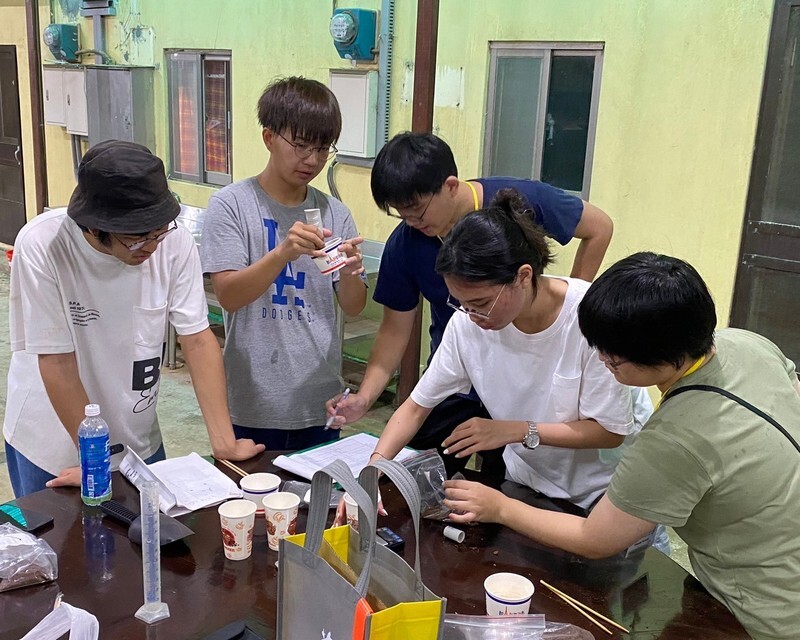 Students using the pH meter to measure soil pH (Photographer: Tetsuro Den)
Students using the pH meter to measure soil pH (Photographer: Tetsuro Den)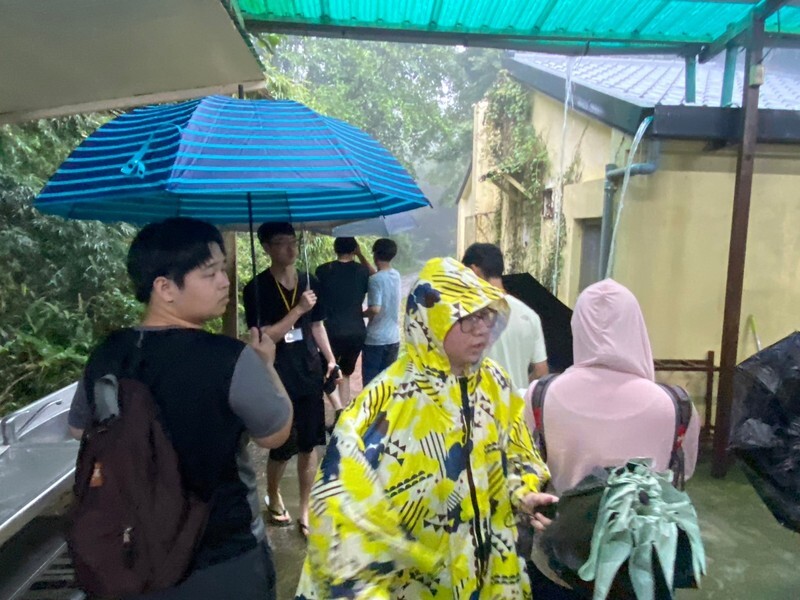 Students helping each other during the heavy rain (Photographer: Tetsuro Den)
Students helping each other during the heavy rain (Photographer: Tetsuro Den)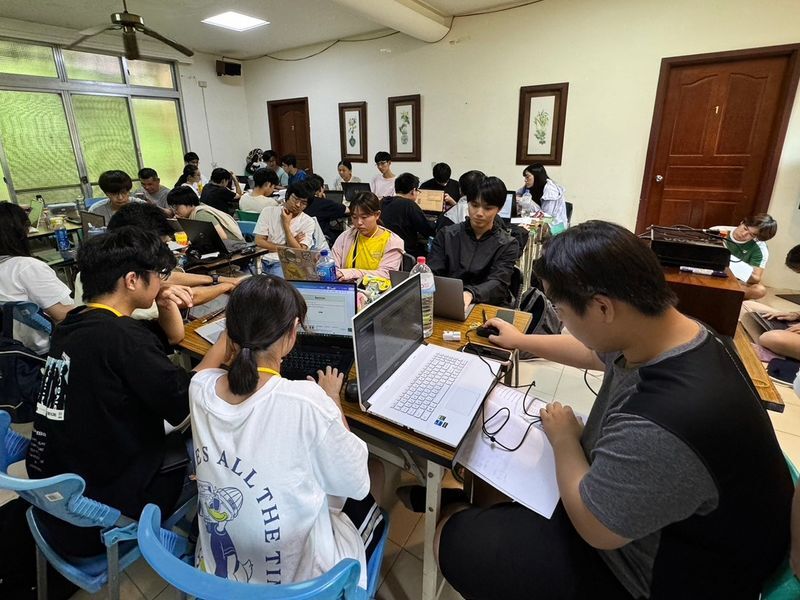 Students from each group diligently preparing for the next day's presentation (Photographer: Chiao-Chu Chang)
Students from each group diligently preparing for the next day's presentation (Photographer: Chiao-Chu Chang)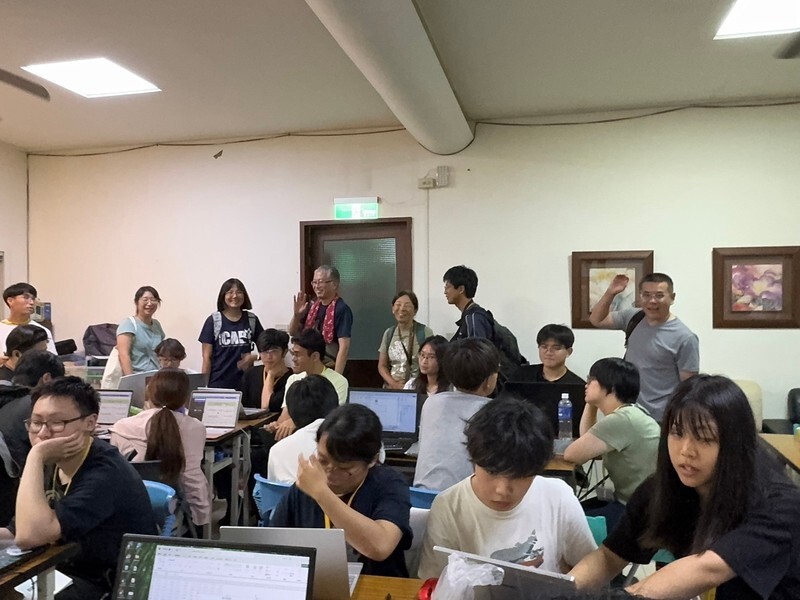 Teachers encouraging the students who continued working late into the night before heading back to rest (Photographer: Chiao-Chu Chang)
Teachers encouraging the students who continued working late into the night before heading back to rest (Photographer: Chiao-Chu Chang)Day 5(August 16) The order of the presentations was determined by a random R code written by Professor Chi-Cheng Liao, and the presentations began promptly at 7:30 AM. Each group worked hard to present their measurements and analysis results from the past few days in English. After the presentations concluded, the students packed their luggage and prepared to say goodbye to Alibang. Before leaving, they took a group photo with the Alibang staff to thank them for their care over the past five days. After boarding the tour bus, the group headed to Jinshan Old Street, where the Taiwanese students introduced their peers from the University of the Ryukyus to Taiwan’s old street culture and cuisine. After lunch, they took the bus to Chinese Culture University, where the teachers and students placed their luggage in the dormitory and rested for a while. At 5 PM, they took the bus again to Haibawang Restaurant for the farewell party. First, certificates were awarded to the professors, teaching assistants, and all the students for participating and completing the course. Awards and prizes were then given to the group with the best presentation. Afterward, everyone happily enjoyed dinner together.
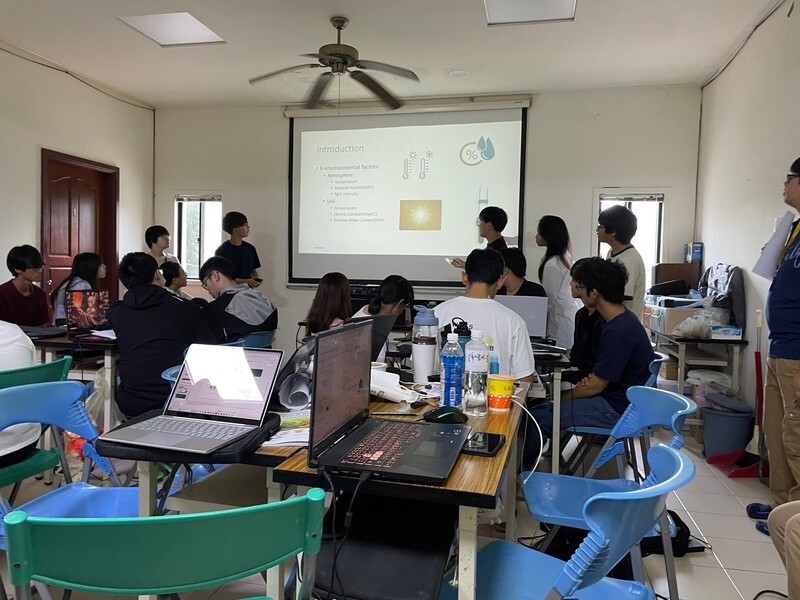 Group D presenting their oral report (Photographer: Yi-Hui Chen)
Group D presenting their oral report (Photographer: Yi-Hui Chen)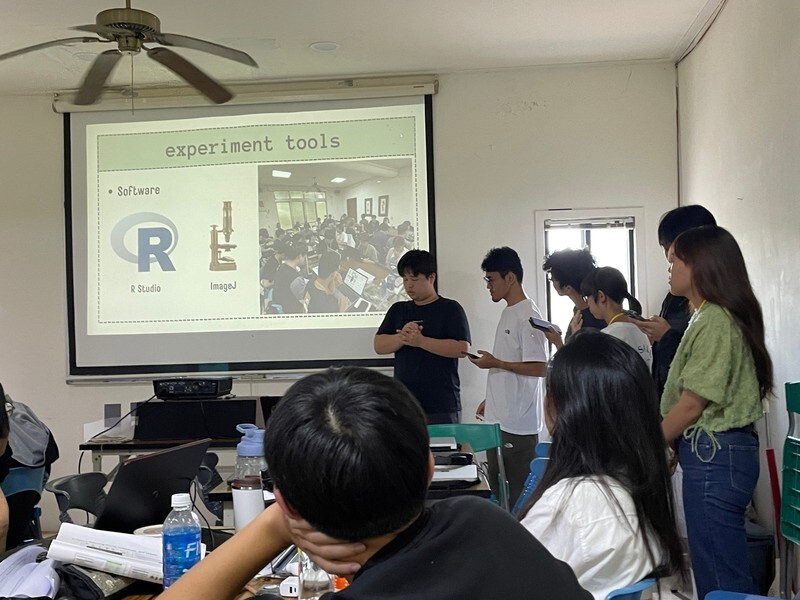 Group B presenting their oral report (Photographer: Yi-Hui Chen)
Group B presenting their oral report (Photographer: Yi-Hui Chen)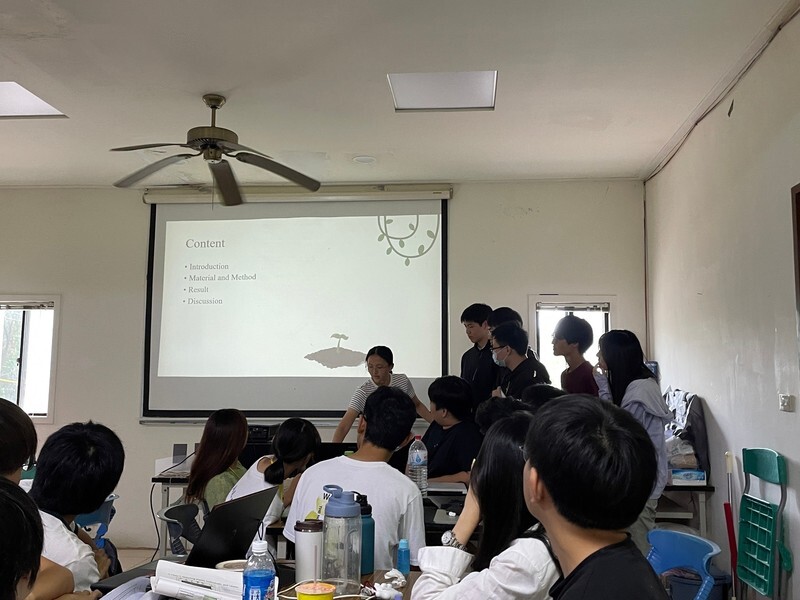 Group A presenting their oral report (Photographer: Yi-Hui Chen)
Group A presenting their oral report (Photographer: Yi-Hui Chen)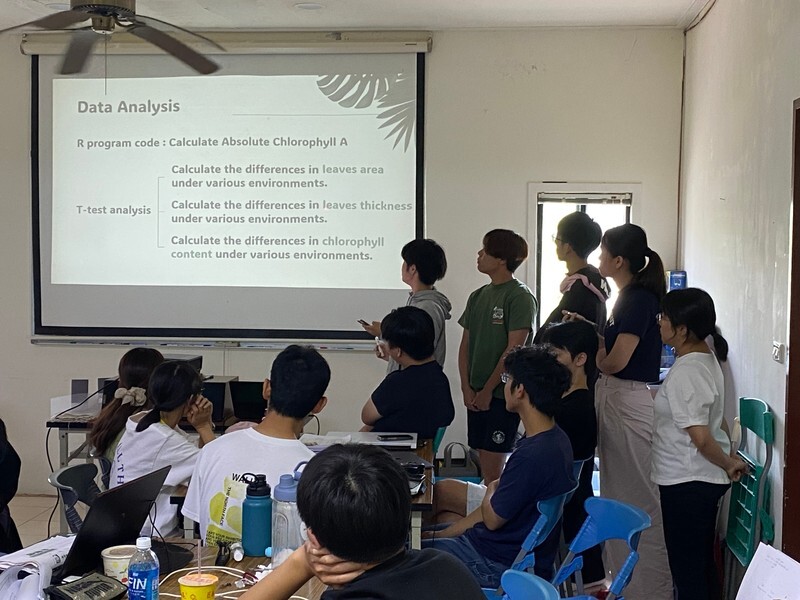 Group C presenting their oral report (Photographer: Tetsuro Den)
Group C presenting their oral report (Photographer: Tetsuro Den)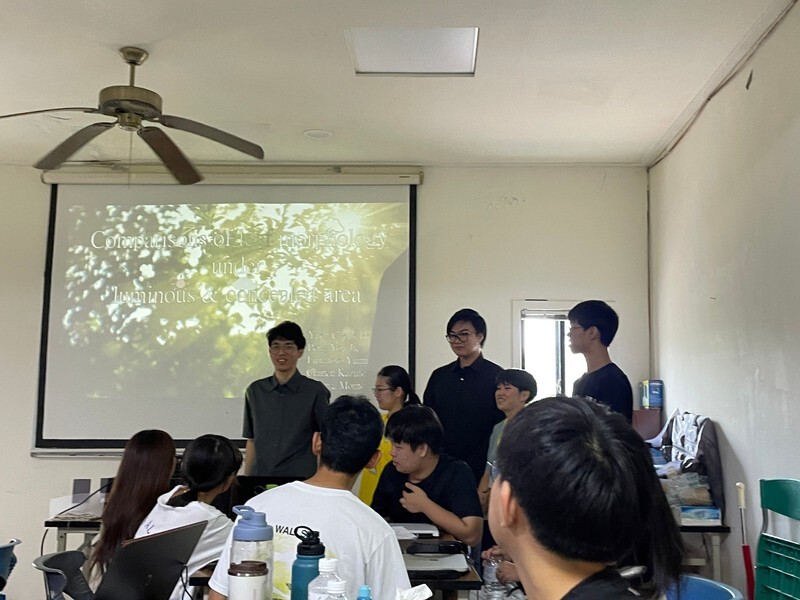 Group E presenting their oral report (Photographer: Yi-Hui Chen)
Group E presenting their oral report (Photographer: Yi-Hui Chen)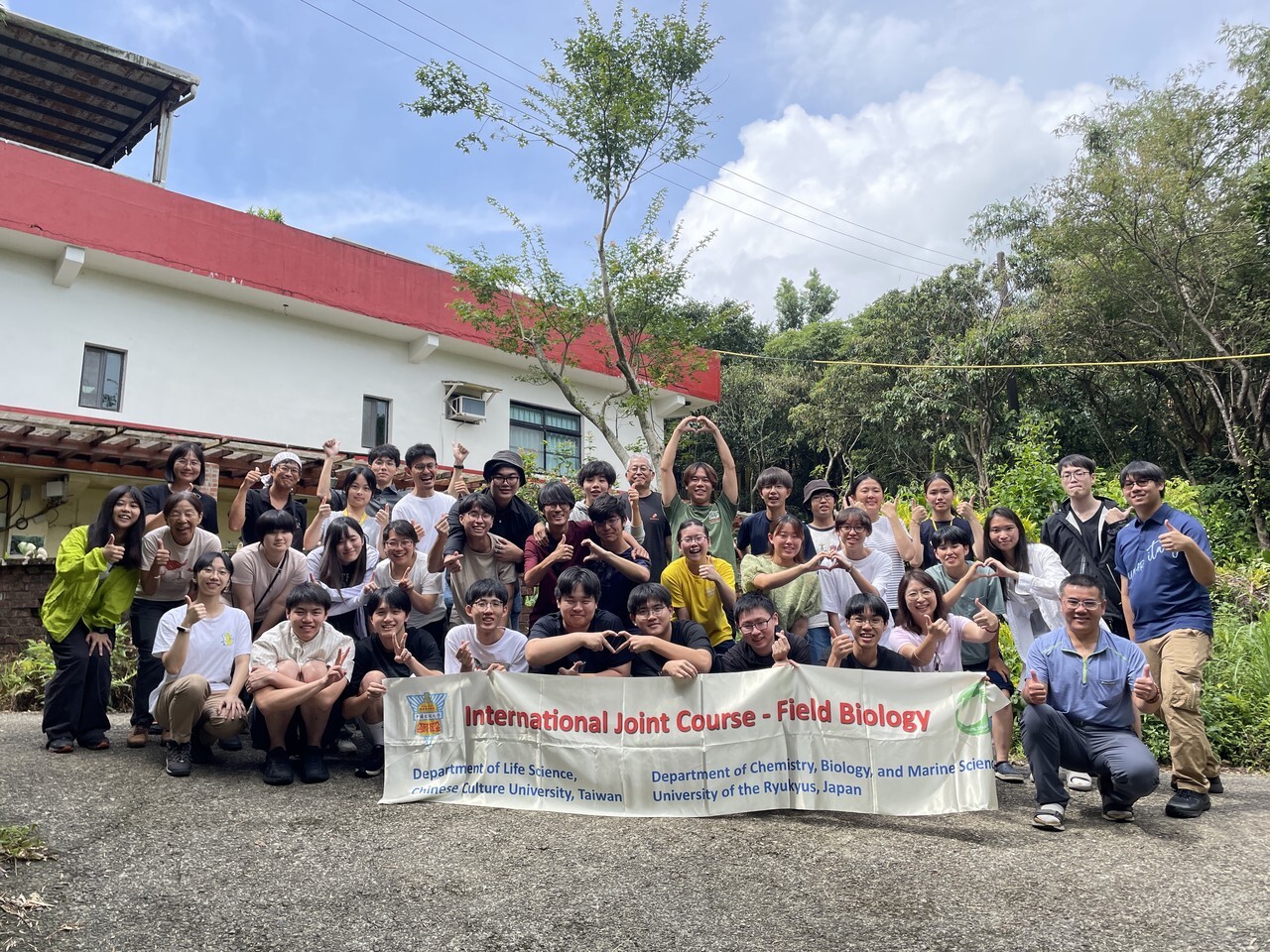 Group photo with the Alibang staff (Photographer: Yi-Hui Chen)
Group photo with the Alibang staff (Photographer: Yi-Hui Chen)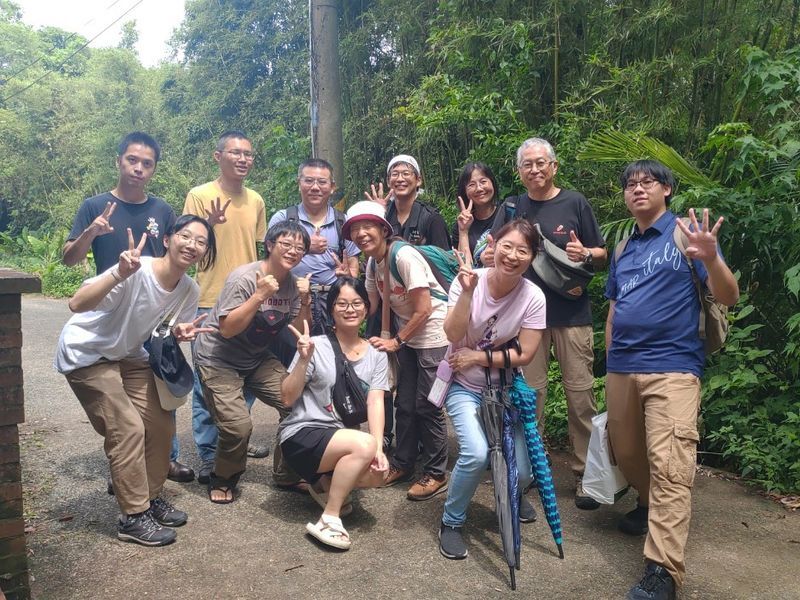 Photo with the teachers, teaching assistants, and staff (Photographer: I-Chieh Tseng)
Photo with the teachers, teaching assistants, and staff (Photographer: I-Chieh Tseng)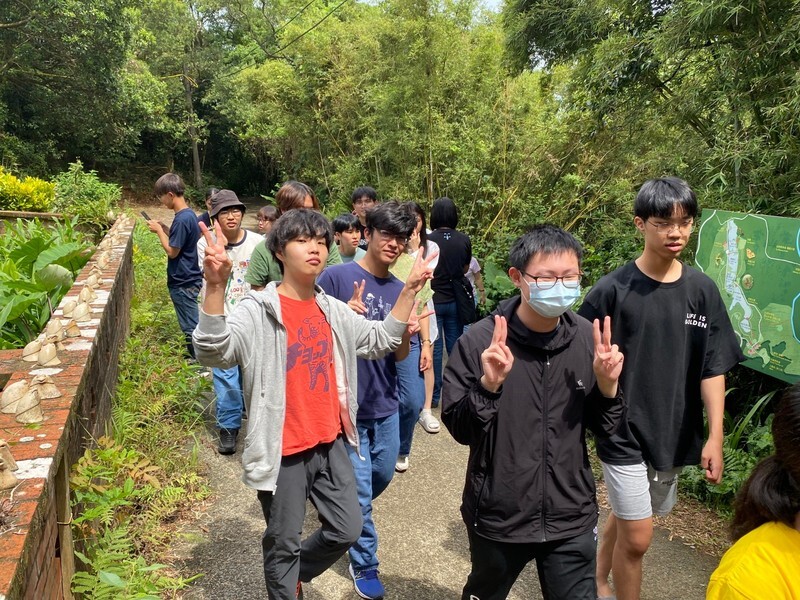 Happy students after the presentations (Photographer: Tetsuro Den)
Happy students after the presentations (Photographer: Tetsuro Den)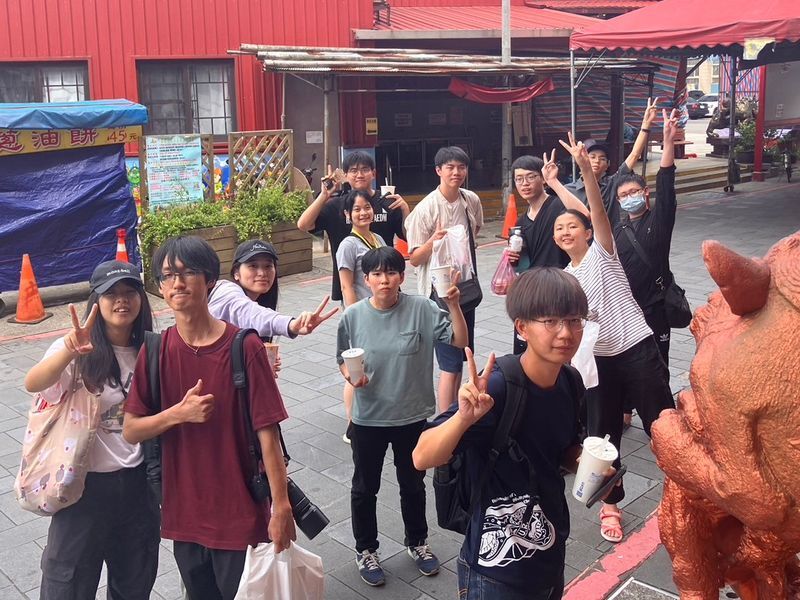 Group photo at Jinshan Old Street (Photographer: Tetsuhei Higashi)
Group photo at Jinshan Old Street (Photographer: Tetsuhei Higashi)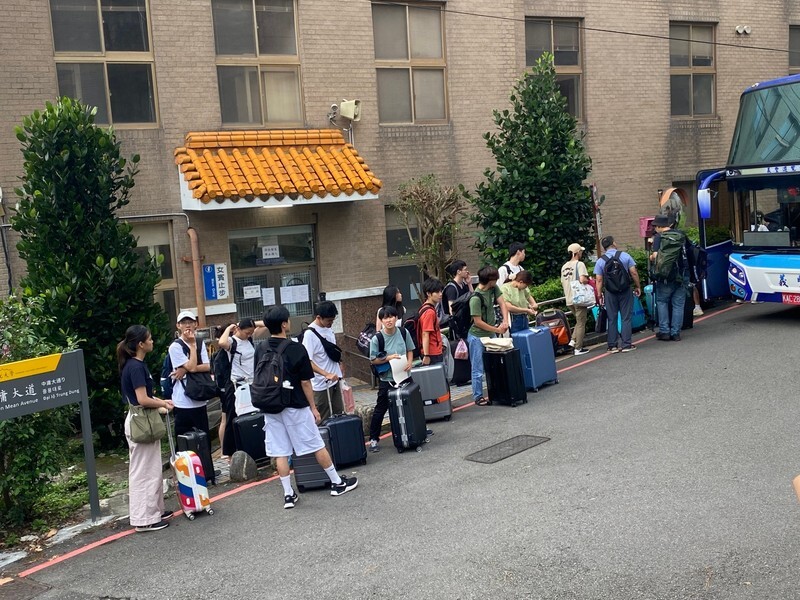 Students preparing to place their luggage at Chinese Culture University (Photographer: Tetsuro Den)
Students preparing to place their luggage at Chinese Culture University (Photographer: Tetsuro Den)_240821_4.jpg) Professor Mu-Chin Fu presenting a certificate and gift to Professor Den for his assistance with the course (Photographer: Tetsuhei Higashi)
Professor Mu-Chin Fu presenting a certificate and gift to Professor Den for his assistance with the course (Photographer: Tetsuhei Higashi)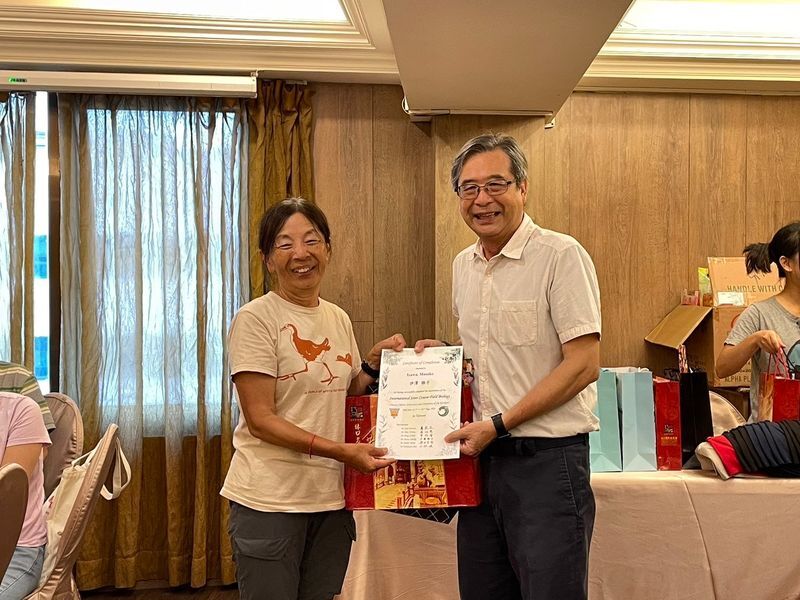 Professor Guang-Hui Lu presenting a certificate and gift to Professor Izawa for his assistance with the course (Photographer: Yen Li)
Professor Guang-Hui Lu presenting a certificate and gift to Professor Izawa for his assistance with the course (Photographer: Yen Li)_240821_5.jpg) Professor Tsung-Meng Wu, head of the Department of Life Sciences, presenting a certificate and gift to Professor Kobayashi for his assistance with the course (Photographer: Yen Li)
Professor Tsung-Meng Wu, head of the Department of Life Sciences, presenting a certificate and gift to Professor Kobayashi for his assistance with the course (Photographer: Yen Li)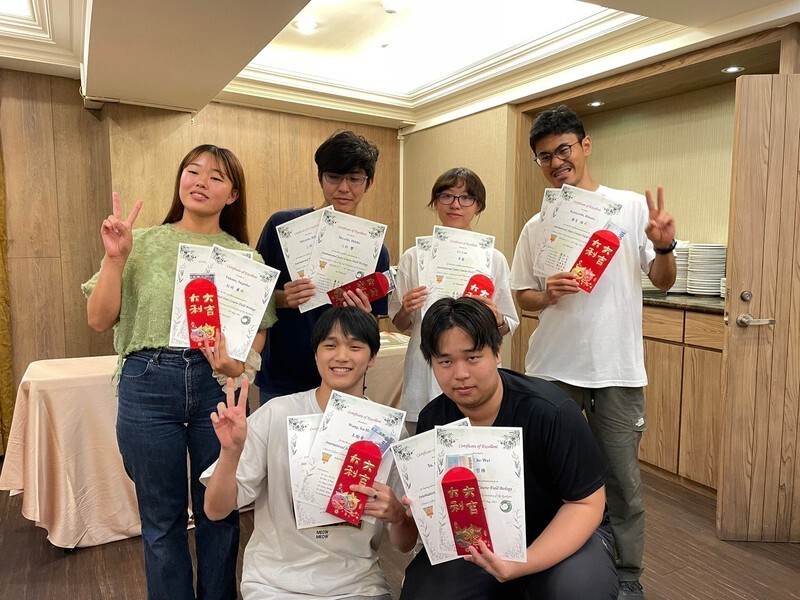 Group photo of the group with the best presentation after receiving their certificate and prize (Photographer: Yen Li)
Group photo of the group with the best presentation after receiving their certificate and prize (Photographer: Yen Li) Photo of the professors and teaching assistants (Photographer: Yi-Hui Chen)
Photo of the professors and teaching assistants (Photographer: Yi-Hui Chen)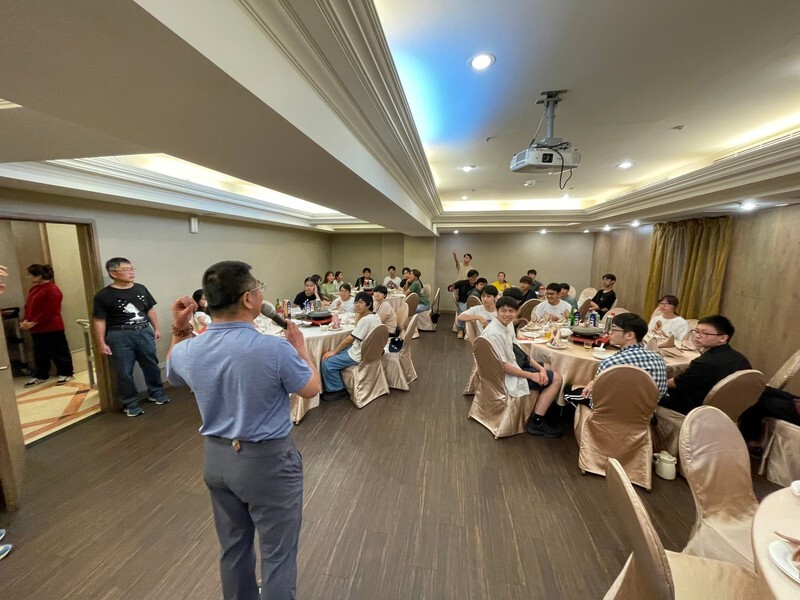 Farewell party hosted by Professor Chi-Cheng Liao (Photographer: Yi-Hui Chen)
Farewell party hosted by Professor Chi-Cheng Liao (Photographer: Yi-Hui Chen)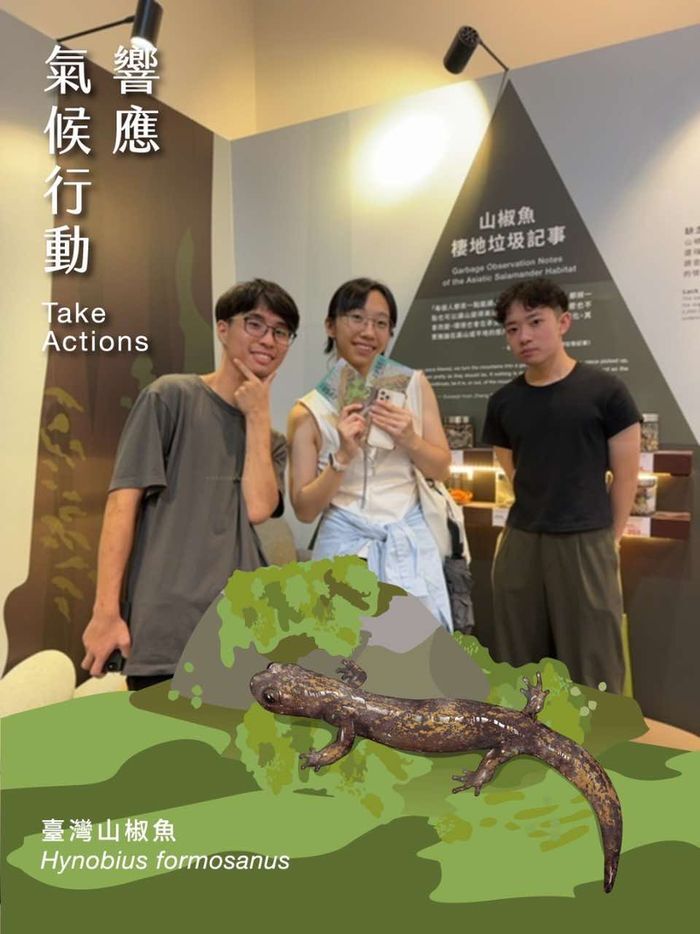 The teaching assistants visiting the special exhibition on salamanders at the zoo (Photographer: Chiao-Chu Chang)
The teaching assistants visiting the special exhibition on salamanders at the zoo (Photographer: Chiao-Chu Chang)Day 6 (August 17th) After breakfast, all students took the bus and MRT to visit the Taipei Zoo. The teachers and students gathered together and entered the zoo. After the teachers reminded the students about the roll-call time in the evening, the whole day of free activities began. The Taiwanese students warmly guided the students from the University of the Ryukyus, enjoying the entire day of free time in Taipei.
 The teaching assistants together at the Taipei Pokémon Center (Photographer: Zhang Qiaozhu)
The teaching assistants together at the Taipei Pokémon Center (Photographer: Zhang Qiaozhu)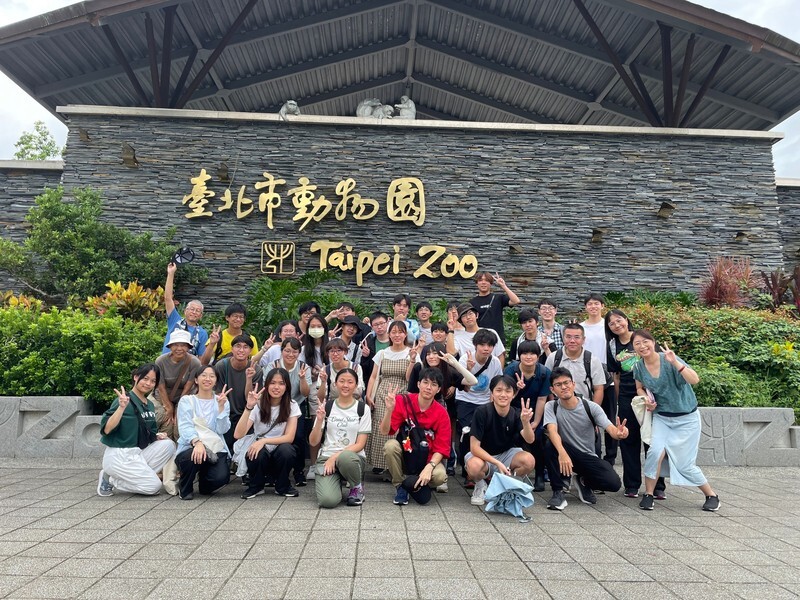 Group photo of all teachers and students (Photographer: Chen Yihui)
Group photo of all teachers and students (Photographer: Chen Yihui).jpg) Teachers taking a photo with the zoo statues (Photographer: Chen Yihui)
Teachers taking a photo with the zoo statues (Photographer: Chen Yihui) Students enjoying dinner together at Dazhuang Hall (Photographer: Li Yan)
Students enjoying dinner together at Dazhuang Hall (Photographer: Li Yan)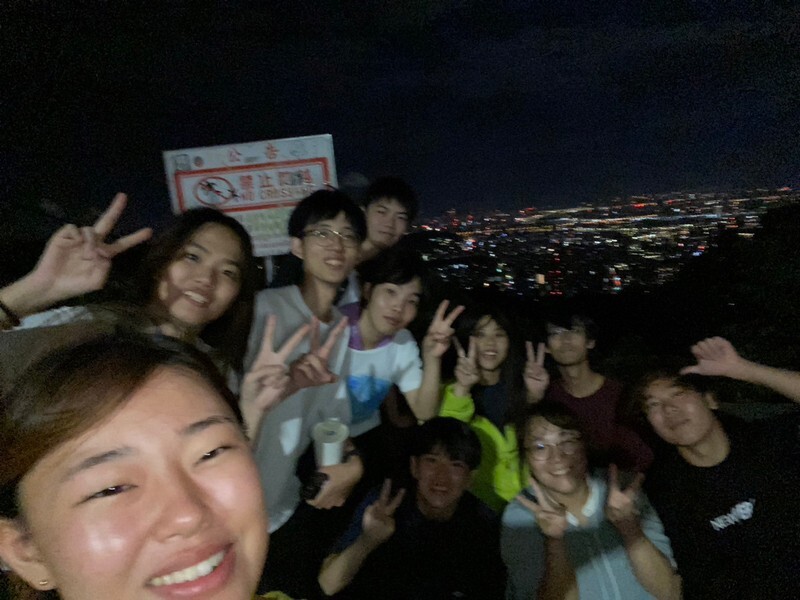 Students enjoying the night view of Taipei together (Photographer: Sugio Kaoruno)
Students enjoying the night view of Taipei together (Photographer: Sugio Kaoruno)Day 7 (August 18th) was the last day of the course. After breakfast, all teachers and students packed their luggage onto the tour bus and headed to Taipei Main Station. The teachers reminded the students of the meeting time at Taoyuan Airport, and then the students began their final half-day of free activities. At 2:30 p.m., all teachers and students gathered at Terminal 2 of Taoyuan Airport to bid farewell to the students and teachers from the University of the Ryukyus. After a final group photo, the students reluctantly said goodbye to each other and sent their best wishes. The course concluded successfully. See you next year at the University of the Ryukyus!
.jpg) Teachers enjoying lunch together (Photographer: Zeng Yijie)
Teachers enjoying lunch together (Photographer: Zeng Yijie).jpg)
Students having a meal together at a noodle restaurant in Taipei (Photographer: Yuan Zhuoxi)
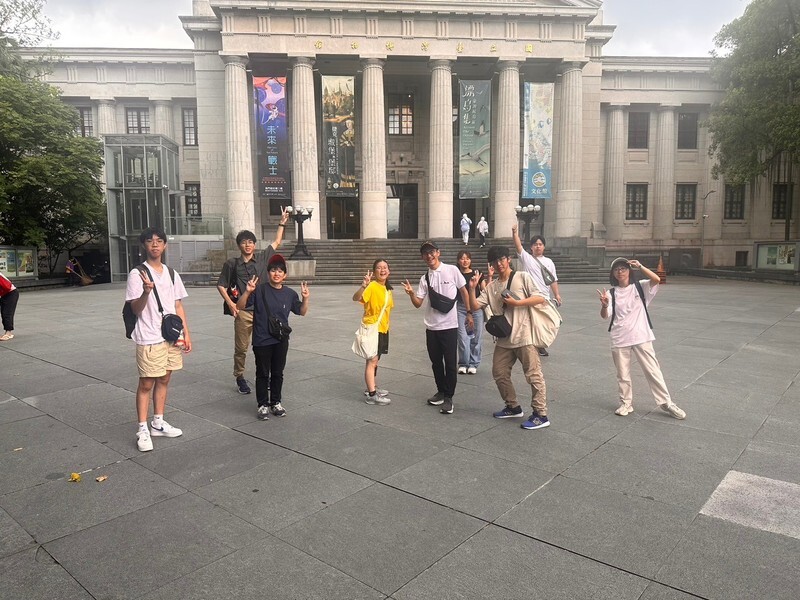 Students visiting the Taiwan Museum (Photographer: Yuan Zhuoxi)
Students visiting the Taiwan Museum (Photographer: Yuan Zhuoxi)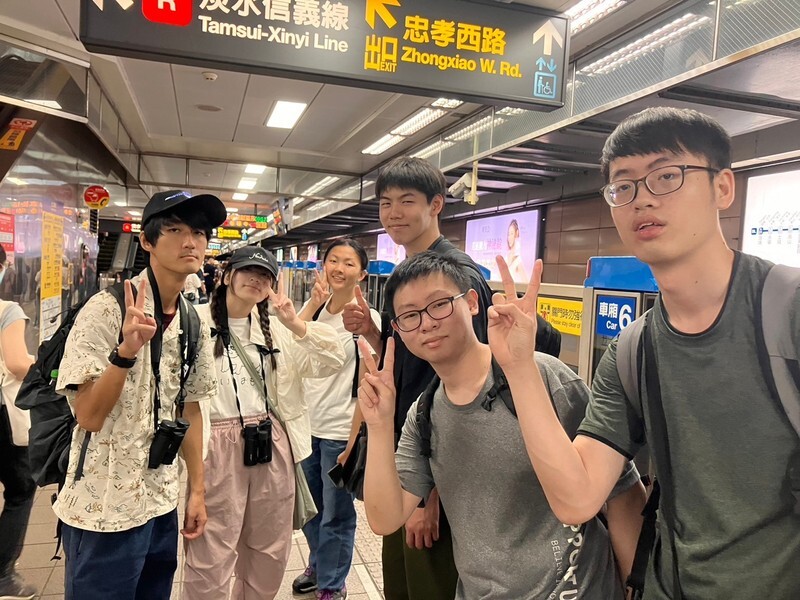 Students taking the MRT together, preparing to head to the airport (Photographer: Higashi Tetsuhira)
Students taking the MRT together, preparing to head to the airport (Photographer: Higashi Tetsuhira)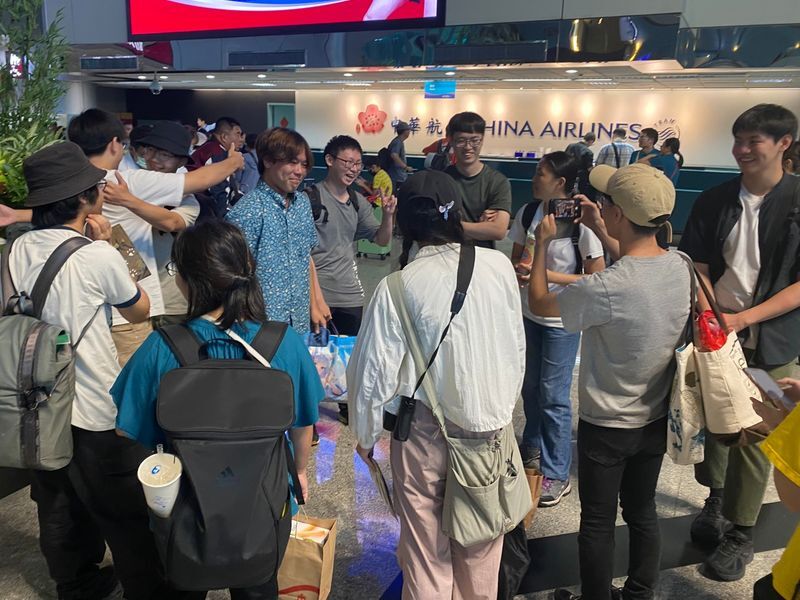 Students saying farewell to each other with reluctance (Photographer: Denta Tetsurou)
Students saying farewell to each other with reluctance (Photographer: Denta Tetsurou)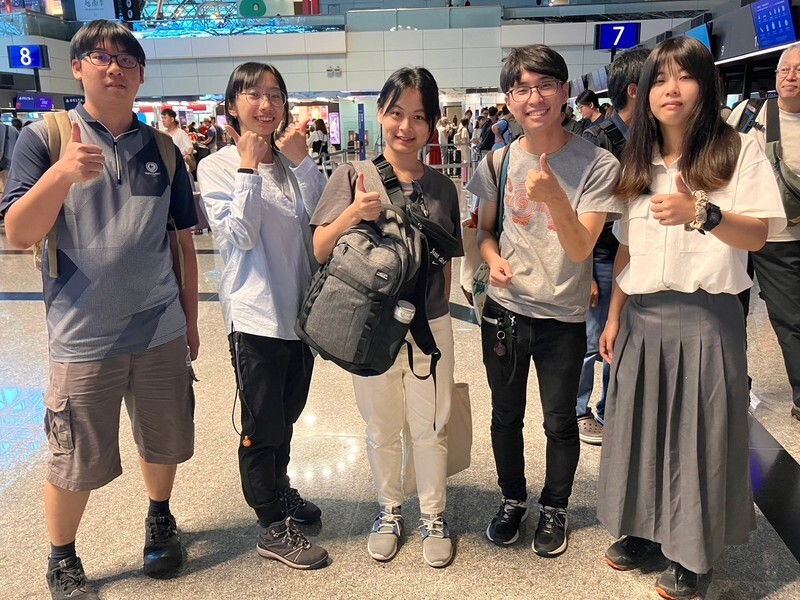 Happy group photo of the teaching assistants (Photographer: Higashi Tetsuhira)
Happy group photo of the teaching assistants (Photographer: Higashi Tetsuhira)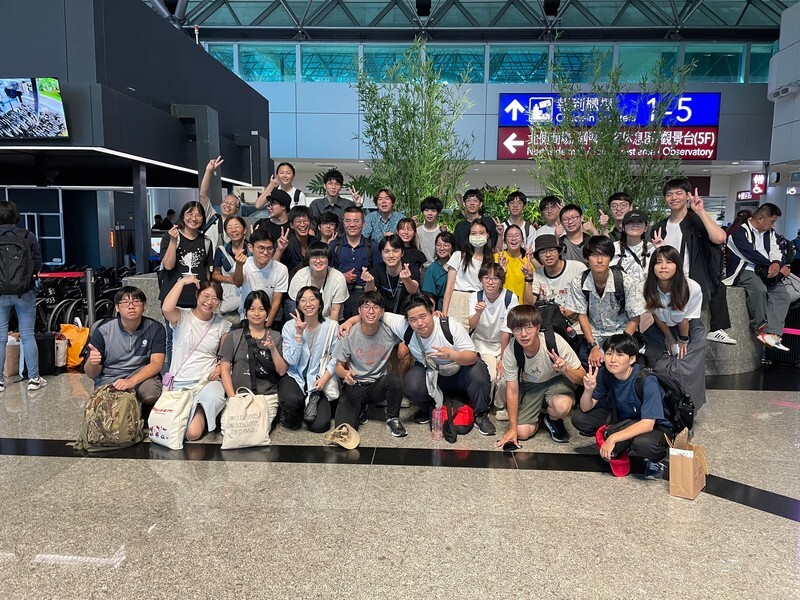 Final group photo of all teachers and students (Photographer: Chen Yihui)
Final group photo of all teachers and students (Photographer: Chen Yihui)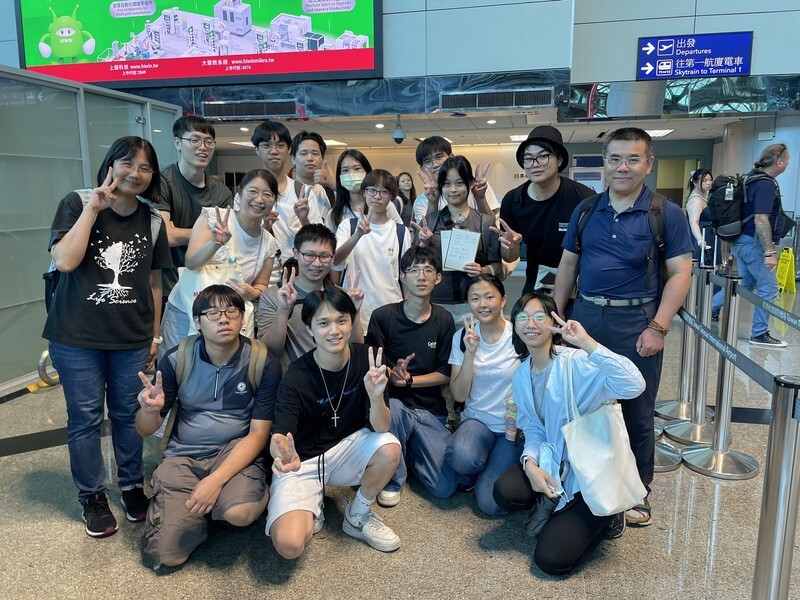 Group photo of the Taiwanese teachers and students (Photographer: Chen Yihui)
Group photo of the Taiwanese teachers and students (Photographer: Chen Yihui)